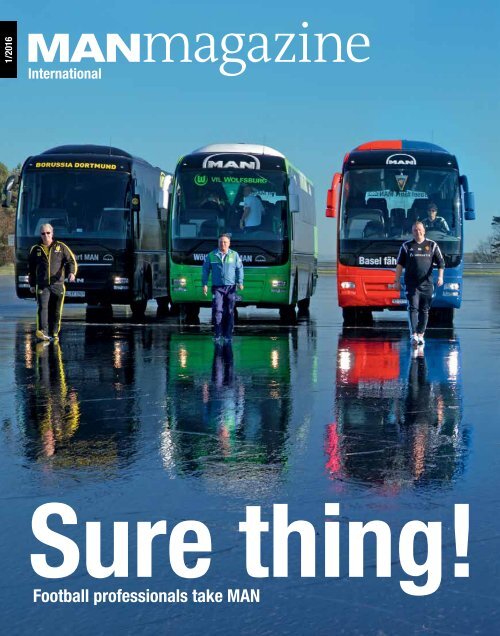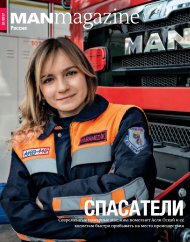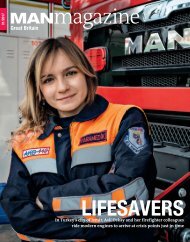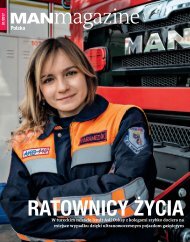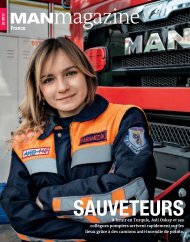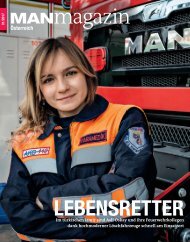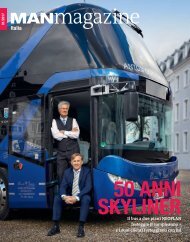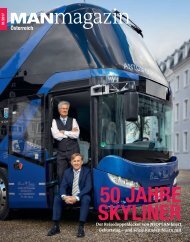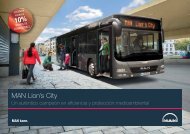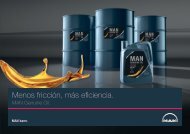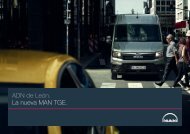MANmagazin edition Bus 1/2016 International
In this issue of MANmagazine, we accompany the team coach drivers of football stars during their safety training sessions conducted by MAN ProfiDrive. For even the very best have to practise. You can also read up on why the MAN Lion’s Intercity makes for the perfect vehicle in France’s Brittany region, learn about the Bus Modification Centre in East Germany’s city of Plauen and ride along on a bus train through Munich.
In this issue of MANmagazine, we accompany the team coach drivers of football stars during their safety training sessions conducted by MAN ProfiDrive. For even the very best have to practise. You can also read up on why the MAN Lion’s Intercity makes for the perfect vehicle in France’s Brittany region, learn about the Bus Modification Centre in East Germany’s city of Plauen and ride along on a bus train through Munich.
You also want an ePaper? Increase the reach of your titles
YUMPU automatically turns print PDFs into web optimized ePapers that Google loves.
1/<strong>2016</strong><br />
<strong>International</strong><br />
Sure thing!<br />
Football professionals take MAN
1/<strong>2016</strong><br />
Explore much<br />
more of<br />
on your tablet.<br />
digitally<br />
04<br />
14<br />
content<br />
<strong>International</strong><br />
for Android<br />
Simply<br />
download the<br />
app for free:<br />
for ios<br />
The best of MAN’s world<br />
How do the drivers of premier league football<br />
clubs prepare for the important task of<br />
safely transporting the stars to their games?<br />
What characteristics render the Lion’s Intercity<br />
a perfect school bus? And which challenges<br />
are met by MAN engineers during bus testing<br />
in the Sierra Nevada’s high-summer<br />
months? In this <strong>edition</strong> of <strong>MANmagazin</strong>e, we<br />
1/<strong>2016</strong><br />
<strong>International</strong><br />
Sure thing!<br />
Football professionals take MAN<br />
once again focus on the topics of technology,<br />
vehicles and mobility. Coverage, interviews<br />
and features on and about buses offer a diverse<br />
read of discovery.<br />
Enjoy and experience the printed <strong>edition</strong><br />
of <strong>MANmagazin</strong>e or download a digital tablet<br />
version for free, which is available as an app<br />
for iOS and Android.<br />
masthead<br />
<strong>MANmagazin</strong>e is published twice a year<br />
in 16 languages.<br />
Publisher MAN Truck & <strong>Bus</strong><br />
Stefan Klatt (V.i.S.d.P.),<br />
Dachauer Straße 667, 80995 Munich, Germany<br />
EDITOR IN CHIEF & project Manager<br />
Joachim Kelz, Tel.: +49. 89. 1580-1175,<br />
magazin@man.eu, www.man.eu<br />
Publisher C3 Creative Code and Content GmbH,<br />
Heiligegeistkirchplatz 1, 10178 Berlin, Germany<br />
Tel.: +49 30 44032-0, www.c3.co,<br />
Shareholders of C3 Creative Code and Content GmbH<br />
are the Burda Gesellschaft mit beschränkter Haftung<br />
(limited liability company), Offenburg, and the KB<br />
Holding GmbH, Berlin, with 50% each. Sole shareholder<br />
of the Burda Gesellschaft mit beschränkter Haftung is<br />
the Hubert Burda Media Holding Kommanditgesellschaft<br />
(limited partnership), Offenburg. Shareholders<br />
of KB Holding GmbH are Mr Lukas Kircher (managing<br />
director, Berlin) and Mr Rainer Burkhardt<br />
(managing director, Berlin) with 50% each.<br />
Head of CONTENT UNIT Klaus-Peter Hilger<br />
Editors & Authors Yasmine Sailer (resp.),<br />
Cedric Arnaud. Freelance authors: Marcus Schick,<br />
Wolfgang Tschakert<br />
international editors Patricia Preston<br />
(resp., freelance editor), Caroline Evans (freelance),<br />
Asa C. Tomash<br />
MANAgiNg editor Sara Austen-Schrick<br />
Graphics Christian Kühn, Tom Märkl (freelance),<br />
Marika Simon, Linda Lorenz<br />
Photo editor Elke Maria Latinovic, Silke Frohmann<br />
(freelance)<br />
cover Bernd Jaufmann<br />
productioN C3 Creative Code and Content GmbH<br />
Printing Gotteswinter und Aumaier GmbH,<br />
Joseph-Dollinger-Bogen 22, 80807 Munich, Germany<br />
Reproduction permitted with reference.<br />
Any changes must be coordinated with the editors.<br />
subscription service Thomas Mahler GmbH,<br />
Postfach 50 04 65, 80974 Munich, Germany<br />
Tel.: +49. 89. 1580-3724,<br />
Thomas.Mahler-ext@man.eu<br />
Advertising service Zeitzeichen Vertriebs GmbH,<br />
Radka Neumann, Tel.: +49. 8323. 9984630,<br />
radkaneumann@zeitzeichen.de<br />
Copyright ©<strong>2016</strong> MAN and C3 Creative Code and<br />
Content GmbH<br />
Photos: APPLE INC. Pr<br />
20<br />
COVER STORY<br />
At the training facility of Germany’s<br />
automobile club ADAC, the coach drivers<br />
of football pros practice how to safely<br />
transport the players to their games.<br />
32<br />
38<br />
04 Swiss travels on a postbus<br />
Astrid and Fred Krummenacher drive an<br />
MAN Lion’s Regio through Graubünden for<br />
the PostAuto Schweiz authority.<br />
06 Oldtimer reborn<br />
A 42-year-old Büssing bus receives a new<br />
lease on life from MAN trainees.<br />
08 Rock star<br />
An MAN truck turns party platform.<br />
10 News<br />
Current reports from MAN’s world<br />
14 Stress test under the scorching sky<br />
In Spain’s Sierra Nevada, MAN and<br />
NEOPLAN buses and coaches are pushed<br />
to the very limit.<br />
20 Training for excellence<br />
Even the very best must practise: the<br />
team coach drivers of football stars during<br />
their safety drills.<br />
26 Revéille to school<br />
Brand-new MAN Lion’s Intercity buses<br />
provide valuable transport services for the<br />
school commute in the west of France.<br />
32 Powerful pairings<br />
Munich’s public transport authorities<br />
rely on the efficient and flexible bus<br />
trains of MAN.<br />
38 The black shark<br />
A luxury team coach of the Cologne Sharks<br />
hockey team was customised in<br />
the <strong>Bus</strong> Modification Centre Plauen.<br />
02<br />
03
1/<strong>2016</strong><br />
Nifty vehicle: The MAN Lion’s<br />
Regio negotiates narrow village<br />
streets without difficulty.<br />
my man<br />
Swiss travels<br />
on a postbus<br />
Photos: Christian Grund<br />
Postbuses are among the most essential<br />
means of public transport in Switzerland. Carrying<br />
commuters and travellers alike, the yellow<br />
buses not only service alpine side valleys, regions<br />
without a rail connection and tourist destinations,<br />
but serve urban areas too. In the Canton<br />
of Graubünden, PostAuto Schweiz deploys<br />
22 MAN Lion’s Regio buses, which are also operated<br />
by drivers Astrid and Fred Krummenacher.<br />
What do you particularly like about the<br />
vehicle? Astrid Krummenacher: The MAN<br />
bus drives very responsively, and has an extremely<br />
high steering angle. So it is actually<br />
very agile despite the long wheel base.<br />
Fred Krummenacher: The timeless, aesthetically<br />
pleasing design, the powerful<br />
sound of the engine – driving an MAN vehicle<br />
is a simply a pleasure.<br />
Which routes do you cover with the bus?<br />
Fred Krummenacher: We service four different<br />
routes. Starting from Chur, either the<br />
Julier Pass line to St. Moritz or to Davos,<br />
Flims-Laax or Bellinzona. Each of these lines<br />
has its own special challenges. On the Julier<br />
Pass line, it’s the steep gradients, Davos means<br />
negotiating the tight village streets, while the<br />
Bellinzona route represents a combination of<br />
motorway stretches with the climb to the San<br />
Bernardino Tunnel, at an altitude of 1,608 metres<br />
above sea level. The MAN bus copes with<br />
it all splendidly, it is just the right vehicle for<br />
the challenges of this varied landscape.<br />
What characterises MAN in your view?<br />
Astrid Krummenacher: The quality and the<br />
superb workmanship. MAN’s longtime experience<br />
in building buses make a real and perceptible<br />
difference.<br />
Fred Krummenacher: The elaborate components<br />
such as the outer mirror, or the arrangement<br />
of the instruments at the driver<br />
seat and the customer-friendly interior.<br />
How do your passengers take to the bus?<br />
Astrid Krummenacher: Passengers find it<br />
very pleasant to travel on the Lion’s Regio. The<br />
“Driving an MAN vehicle<br />
is simply a pleasure.”<br />
Fred Krummenacher, bus driver for PostAuto Schweiz AG<br />
Astrid Krummenacher has been a bus driver since 2001,<br />
while Fred has been driving buses since 1990. The<br />
couple also met for the first time on a bus 24 years ago<br />
while travelling to a youth meeting.<br />
enormous stowage capacities are particularly<br />
valued by passengers with a lot of luggage.<br />
Fred Krummenacher: And there are even<br />
passengers who decide quite spontaneously<br />
to board an MAN bus at a postbus station, no<br />
matter what the destination might be...<br />
What do you particularly like about<br />
your job? Astrid Krummenacher: Contact<br />
with the passengers means a lot to me. And<br />
being on the road with such a large vehicle is<br />
a challenge that I just appreciate very much.<br />
Fred Krummenacher: I like making the trip<br />
as pleasant as possible for the passengers. Vacationers<br />
should already enjoy themselves<br />
while travelling to their destinations. Naturally,<br />
it is also nice to share my work with my wife.<br />
Experience a<br />
postbus trip with<br />
the Krummenachers<br />
on the app!<br />
04<br />
05
1/<strong>2016</strong><br />
As good as new: Due to weeks<br />
of renovation work, the historic<br />
Büssing bus is back in top shape.<br />
In dire need of restoration:<br />
After 14 years of service in<br />
Zurich, the bus was no<br />
longer fit to drive.<br />
Oldtimer reborn<br />
On the occasion of its centenary, MAN<br />
received a very special gift by the municipal<br />
transport authority of Zürich (VBZ), namely a<br />
42-year-old Büssing bus that had served the inner<br />
city lines of Zurich from 1974 to 1988. In<br />
order to accelerate passenger flow, the bus already<br />
featured three rather than two doors,<br />
which was standard at the time – thus playing<br />
a pioneering role in terms of urban mobility.<br />
Upon reaching the end of its service life<br />
at VBZ, the vintage bus had no longer been<br />
roadworthy. Yet a team of trainees at MAN’s<br />
branch located in Otelfingen, near Zurich,<br />
succeeded in restoring the historic bus to its<br />
former glory. Per the instruction efforts of<br />
Training Manager Peter Sterchi, the trainees<br />
spent several weeks transforming the brakes,<br />
engine, on-board electronics and side panels<br />
back into state-of-the-art condition, while<br />
also replacing the blue and white paint as well<br />
as the vehicle stickers.<br />
Upon completion of the professional<br />
restoration job, the bus was utilised for press<br />
trips and today supplements the extensive<br />
collection of historic vehicles at the MAN <strong>Bus</strong><br />
Forum in Munich, Germany.<br />
Photos: MAN<br />
Love of detail: The MAN trainees in<br />
Zürich-Otelfingen faithfully restored<br />
the bus to its original condition.<br />
06<br />
07
1/<strong>2016</strong><br />
Rock st ar<br />
Rock ’n’ roll: Spectators at<br />
the Wacken Open Air<br />
Festival truly stood in awe<br />
of the Thundertruck<br />
Matt black power pack:<br />
The Teufel Thundertruck is a<br />
party vehicle on eight wheels.<br />
Photos: Teufel.de ( 2)<br />
Thirteen square metres of dance floor,<br />
four fog machines, a light system, a bar and<br />
the sound vibrating from 10 Teufel Rockster<br />
loudspeakers with a combined power of more<br />
than 8,000 watts: The Thundertruck, aptly<br />
named Teufel (or devil), is pure rock ’n’ roll on<br />
wheels. This wicked vehicle celebrated its first<br />
public appearance on the occasion of Berlin’s<br />
Christopher Street Day parade in the summer<br />
of 2015. Since then, the truck has hosted perfect<br />
parties at numerous events, including the<br />
Gamescom trade fair in Cologne, the IFA<br />
consumer electronics show in Berlin and the<br />
heavy-metal Wacken Open Air Festival.<br />
The basis of the Thundertruck is a former<br />
German military vehicle built by MAN in 1977.<br />
Commissioned by the German hi-fi equipment<br />
manufacturer Teufel, a team of eight<br />
people worked seven weeks to convert the<br />
MAN KAT1 8x8 into a rock mobile. The original<br />
chassis of the former transport vehicle was<br />
left intact. While merely the olive-green army<br />
paint gave way to a rock-style matt black, the<br />
opulent fittings and superstructure of the<br />
four-axle truck presented more considerable<br />
challenges. The Teufel Thundertruck features<br />
320 hp, eight wheels and weighs in at 25.4<br />
tonnes – heavy-metal groove at its coolest.<br />
08<br />
09
1/<strong>2016</strong><br />
Desert giants<br />
with 1,000 hp<br />
Sustainability<br />
prize for MAN<br />
<strong>2016</strong><br />
Parts and accessories<br />
MAN Truck & <strong>Bus</strong><br />
MAN Originalteile® Ecoline<br />
At the Dakar Rally <strong>2016</strong>, they were once<br />
again the secret stars: The 55 powerful racing<br />
trucks competing for a fortnight to cover<br />
9,000 kilometres through the deserts of Argentina<br />
and Bolivia in January <strong>2016</strong>. As in the<br />
previous year, MAN was once again the leading<br />
manufacturer in the truck class with<br />
16 racing trucks. For a long time, it was actually<br />
a head-to-head race with Kamaz and Iveco<br />
for the overall victory. Hans Stacey and his<br />
EUROL/VEKA MAN rally team finally crossed<br />
the finishing line in Rosario in fourth place.<br />
The MAN service teams also made a significant<br />
contribution to this applaudable result:<br />
As always, the racing teams were able to<br />
depend on their reliable support. Fifteen of<br />
MAN’s 16 vehicles made it to the finish line,<br />
merely one truck dropped out due to irreparable<br />
crash damage. Besides procuring spare<br />
parts in the desert, the service technicians<br />
also carried out numerous repairs, ranging<br />
from windscreen replacement to crash damages<br />
to cylinder head replacement – all without<br />
a crane, but with five strong men instead.<br />
The newspaper Transport awarded<br />
the “European Transport Prize for<br />
Sustainability <strong>2016</strong>” in Munich last November<br />
and MAN Truck & <strong>Bus</strong> proved<br />
a winner on two counts: first in the<br />
“Parts and Accessories” category and<br />
secondly with Euro-Leasing / MAN<br />
Financial Services – in the “Hire of<br />
Trailers and Commercial Vehicles”<br />
class. Altogether, 17 companies received<br />
awards in 16 different categories.<br />
Bestowed for the third time, the<br />
sustainability prize is designed to encourage<br />
companies in the commercial<br />
vehicles and transport logistics industries<br />
to adopt a sustainable approach.<br />
Platoon prototype: The lead vehicle and trailing vehicle drive convoy-style, saving fuel due to the shortened distance.<br />
Slipstream efficiency<br />
Platooning, a practice whereby several of automated vehicles taking to the roads in<br />
vehicles are assisted by a technological control<br />
system to drive in a convoy with very tion drive from Munich to Rotterdam with<br />
April. MAN participated in the demonstra-<br />
little spacing, is a highly promising solution a platoon prototype. Two serial vehicles<br />
for the mobility of the future. Due to greatly equipped with car-to-car communication<br />
reduced distances, automated and networked<br />
platoon driving allows for reduced ment drove on the motorway, observing a<br />
and the necessary on-board sensor equip-<br />
fuel consumption. Holding the EU Council minimum safety distance of 10 metres. The<br />
Presidency in <strong>2016</strong>, the Netherlands decided demonstration tours were designed to promote<br />
political discussion and encourage the<br />
to highlight the potential of this approach<br />
by organising the “European Truck Platooning<br />
Challenge <strong>2016</strong>”. This involved convoys cepts in the long<br />
realisation of such innovative vehicle con-<br />
term.<br />
Oldest MAN truck in the Middle East<br />
Best MAN driver at the<br />
Dakar Rally <strong>2016</strong>: Hans Stacey<br />
raced to fourth place.<br />
Photos: Robert W. Kranz / Ralleywerk.com, MAN (2)<br />
Proud owner: Walid Seif<br />
with his MAN truck from<br />
1956 (left) and a modern<br />
MAN TGS<br />
Under the auspices of MAN’s centenary,<br />
the company cooperated with MAN importer<br />
Terramar to find the oldest MAN truck in the<br />
Middle East – and succeeded. Built in 1956, a<br />
truck from Damascus proved the winner of<br />
the contest. Owner Walid Seif reported that<br />
the vehicle has been in his family for five decades<br />
and three generations. It travelled everywhere<br />
in the region – from Jordan to Iraq and<br />
Lebanon, while always providing reliable and<br />
tireless service. “We installed an eight-cylinder<br />
engine 25 years ago – and the truck has<br />
been running since then without any need of<br />
repairs,” says Seif. The vehicle is still underway<br />
on the roads of the Middle East today,<br />
transporting goods between Damascus and<br />
the Lebanon on a weekly basis.<br />
10<br />
11
1/<strong>2016</strong><br />
WORLD DEBUT<br />
from MAN Diesel & Turbo<br />
Under the sea:<br />
The submersed compressor<br />
station lies 300 metres<br />
below the water surface<br />
Gold for MAN<br />
Lion’s Intercity<br />
The MAN Lion’s Intercity was awarded<br />
gold by the iF design award <strong>2016</strong> jury in the<br />
category “Automobiles/Vehicles/Bikes”. The<br />
intercity bus made by MAN is therefore one of<br />
merely 75 gold prize winners out of thousands<br />
of submissions.<br />
Bestowed annually by the <strong>International</strong><br />
the launch was a quantum leap for the<br />
oil and gas industry: In September 2015, the<br />
first underwater compressor station for gas<br />
production started up 300 metres below the<br />
water surface and on the bed of the North Sea<br />
off the coast of Norway – a global feat. The station<br />
is equipped with two engine compressor<br />
units from MAN Diesel & Turbo. During the<br />
development phase, MAN worked closely<br />
with the end customer, the Norwegian oil and<br />
gas company Statoil and had continuously<br />
optimised the technology according to customer<br />
requirements.<br />
Compared to the conventional offshore<br />
production of mineral oil and natural gas, the<br />
First launch: The world’s first<br />
submersed compressor station became<br />
operational as of September 2015.<br />
utilisation of the new underwater technology<br />
results not just in lower investment costs, but<br />
especially a significantly higher pumping<br />
rate, which amounts to an additional 36 million<br />
barrel units of oil. At the same time,<br />
energy consumption and CO2 emissions are<br />
reduced. While the natural deposit pressure<br />
decreases continuously, the engine compressor<br />
units from MAN serve to keep pressure<br />
constant throughout the production cycle.<br />
Aker Solutions, general contractor for<br />
Statoil, had ordered the compressors from<br />
MAN Diesel & Turbo in Zurich in 2010. The<br />
contract comprised four engine compressor<br />
units, as well as maintenance and service.<br />
MAN Truck & <strong>Bus</strong> has been supplying<br />
axles to North America through its general<br />
import agent MAN Engines & Components<br />
for 25 years. In <strong>2016</strong>, the company celebrates<br />
a major milestone – the 50,000th axle delivered<br />
to the United States.<br />
An important customer for axles supplied<br />
by MAN is the Canadian bus manufacturer<br />
New Flyer, which orders around 4,000<br />
units every year. With a market share of<br />
Big city traffic: The New Flyer<br />
buses dominate local urban<br />
transport in New York.<br />
New York transport<br />
relies on German axles<br />
almost 50%, the Canadian company is the<br />
market leader in the US and therefore represents<br />
an important cooperation partner for<br />
MAN. In New York, local urban transport is<br />
dominated by New Flyer: The municipal authority<br />
New York City Transit alone operates<br />
around 2,000 of MAN’s bus axles supplied<br />
through New Flyer.<br />
More information about MAN axles can<br />
be found at > www.man.eu/engines-axle<br />
Forum Design company iF, this award is a<br />
world-renowned seal of design quality. Under<br />
consideration of the awards garnered in recent<br />
years – including the red dot design<br />
award and the iF and German Design Awards<br />
– this prize tops off MAN’s successful design<br />
work. Since 2002, the vehicles under the MAN<br />
and NEOPLAN brands have already received<br />
as many as 13 design prizes.<br />
UR:BAN: conclusion of a research project<br />
Interaction of man and machine: Within the framework of<br />
UR:BAN, MAN explored the interface between driver and<br />
commercial vehicle from different angles.<br />
In October 2015, the 31 UR:BAN partners<br />
presented the results of their four-year research<br />
work in Düsseldorf, Germany. Experts<br />
from various UR:BAN projects exhibited about<br />
50 demonstration vehicles. As the only participating<br />
commercial vehicle manufacturer,<br />
MAN was represented by two prototypes and a<br />
walk-in truck cab. The aim of the project was to<br />
render urban transport safer, more efficient<br />
and fluid. The principal focus of MAN was on<br />
the interaction between driver and vehicle.<br />
More about the project: > www.urban-online.org<br />
2 000<br />
engines<br />
have been delivered by MAN Engines &<br />
Components to Viking Yachts, an American<br />
manufacturer of luxury sportfishing boats,<br />
since 1993. The eight- and 12-cylinder<br />
marine engines are ideally suited for<br />
sportfishing boats, as these operate for<br />
up to 1,000 hours per year and must<br />
feature high efficiency, reliability and<br />
economic fuel consumption.<br />
Photos: Aker Solutions/ Subsea, Sorin Morar, plainpicture/Westend61, MAN<br />
Repair updates<br />
in real time<br />
With the Mobile24 Tracking Link, MAN offers users of its<br />
breakdown service, Mobile24, the option of tracking the current<br />
status of a repair assignment. Through the online link, customers<br />
can check at a glance the estimated arrival time of the repair<br />
technician, whether the service expert has started the repair,<br />
and the estimated time as to the conclusion of repair work or<br />
whether it was completed. Utilising this service merely requires<br />
customer registration via a form in the Mobile24 prospectus. The<br />
registration can be dropped off at the MAN support point in<br />
charge and can be cancelled at any time.<br />
1 2<br />
Record data<br />
3<br />
Receive tracking link<br />
@<br />
Tracking website<br />
5 ✔<br />
Report breakdown<br />
4<br />
Click and view<br />
current status<br />
@<br />
Total<br />
transparency:<br />
The Mobile24<br />
Tracking Link<br />
allows<br />
customers to<br />
track the repair<br />
process.<br />
12<br />
13
1/<strong>2016</strong><br />
Stress test<br />
under the scorching sky<br />
During summer trials in Spain’s Sierra Nevada, MAN<br />
and NEOPLAN buses and coaches must prove their<br />
capabilities under extreme conditions. They won’t be<br />
ready for the customer unless they pass these tests.<br />
Photo: Max Kratzer<br />
14<br />
15
1/<strong>2016</strong><br />
Data collection: Probes,<br />
measuring devices and<br />
computers on board the bus<br />
record all relevant test data.<br />
F<br />
inally a bit of shade. Over Calle los<br />
Reyes Católicos – one of Granada’s<br />
grandest streets – wide panels of<br />
cloth are suspended to protect pedestrians<br />
from the glittering sun on the edge of the<br />
Sierra Nevada. Željko Krčelić manoeuvres<br />
his white MAN Lion’s City GL through the picturesque<br />
old town. While his 18-metre articulated<br />
bus draws much attention, the 55-yearold<br />
driver must leave waving hopefuls at bus<br />
stops behind with a gesture of regret. As a matter<br />
of fact, Krčelić desires nothing more than<br />
to get out of the shade and right into the blazing<br />
sun of Andalusia.<br />
Especially those temperatures of more<br />
than 4o°C are the reason why Krčelić has<br />
made the 2,400-kilometre trip from Munich<br />
to Granada in August 2015. Instead of passengers,<br />
sandbags and bulky passenger dummies<br />
occupied the seats. It is time for MAN’s major<br />
summer trials. Krčelić is a vehicle electronics<br />
specialist who has been with MAN for 38<br />
years. The experienced test driver is now taking<br />
part in the summer endurance tests for<br />
the fifth time.<br />
In Granada, the mechatronics engineer<br />
Andreas Ruhtenberg is also on board. He is<br />
responsible for the <strong>Bus</strong> Chassis Test Engineering<br />
department, which examines the electrical<br />
drive systems of articulated buses. “In<br />
conditions of the extreme temperatures prevailing<br />
here, we are investigating the engine<br />
cooling and gear coordination, as well as vehicle<br />
performance at optimal rotational<br />
speeds. The functionality of the door systems,<br />
the air consumption of the pneumatic<br />
doors as well as the air conditioning of the<br />
bus interior are also on our agenda,” says<br />
Ruhtenberg. In order to obtain all this data,<br />
the measuring devices, probes and temperature<br />
sensors are already working at full speed<br />
in the thoroughly wired city bus.<br />
Fasten your seat belts:<br />
dummies simulate real<br />
passengers during the trials.<br />
The journey takes them across the city,<br />
along the river, through narrow streets and<br />
across avenues fringed with plane trees to the<br />
base of the Alhambra. The journey continues<br />
along the urban motorway to a commercial<br />
district close to the Santa Fe quarter. This area<br />
resembles a ghost town: There are well-constructed<br />
roads, pavements, crossings and<br />
roundabouts, yet no buildings or people.<br />
“This is the perfect testing ground for us,<br />
where we are free to simulate and measure all<br />
routine driving situations,” says Krčelić.<br />
250<br />
experts<br />
from MAN’s development<br />
department are in Granada<br />
during the summer tests.<br />
Photos: Max Kratzer<br />
“Once I see our vehicles<br />
at the customer, we have<br />
indeed done a good job.”<br />
Rainer Miksch, responsible for Road Tests at MAN Truck and <strong>Bus</strong><br />
Hairpin trial drive: NEOPLAN touring<br />
coaches are tested in the Sierra<br />
Nevada, while the MAN urban buses<br />
navigate the streets of Granada.<br />
Sun screen: in Granada’s old town, panels<br />
hung over the streets provide welcome shade.<br />
That is precisely the goal of the MAN summer<br />
trials. In tandem with its counterpart in<br />
the winter of northern Sweden, this is the last<br />
major endurance test before the new vehicles<br />
and their technology must prove themselves<br />
on the market. By then, much work and innovative<br />
efforts have gone into the engineering.<br />
“In total, MAN has around 250 development<br />
experts on site in Granada: drivers, engine<br />
mechanics, workshop technicians, application<br />
experts and engineers,” reports 50-year- old<br />
Rainer Miksch, who is responsible for Road<br />
Tests at MAN Truck and <strong>Bus</strong>. This morning<br />
at eight o’clock, he and his project leader<br />
Andreas Ruhtenberg summoned the engineers,<br />
workshop technicians and drivers to<br />
their morning briefing. The hall is filled with<br />
two-storey office containers, where open laptops<br />
sit side by side on the tables. The tangled<br />
maze of cables indicates that all the trial results<br />
are converging here. <strong>Bus</strong>es and trucks are<br />
lined up in the hall and initially all appear to<br />
be well-known vehicles from current production<br />
series. “The technical innovations this<br />
16<br />
17
1/<strong>2016</strong><br />
Good soul: Joseph Betz not only ensures<br />
smooth operations, but also looks after<br />
the well-being of his team.<br />
Test track: A deserted<br />
commercial district near<br />
Santa Fe offers perfect<br />
trial conditions.<br />
year relate to the engines and drive trains,”<br />
says Ruhtenberg. Only signs reading “Test Vehicle”<br />
or “Video Recording Test Vehicle” actually<br />
suggest a special assignment purpose.<br />
“Over the seven weeks of summer testing,<br />
our to-do list includes functional and longterm<br />
endurance tests for engines and gears,<br />
the checking and adjustment of the brake<br />
management system, as well as the functionality<br />
of the innovative driver assistance and<br />
GPS-based cruise control systems,” explains<br />
Miksch, outlining the mission facing his<br />
team. “Just preparing for the trials,” he says,<br />
“takes all of six months. Besides defining the<br />
crucial parameters, all the measurement and<br />
control points must be determined and set<br />
up.” This is already the 19th summer trial for<br />
Miksch. “We started with just two employees<br />
and four cars,” recalls the test manager. “It is<br />
indeed impressive to witness what has<br />
evolved since then.”<br />
Upon concluding the trial runs, all the<br />
test results must be fitted together akin to a<br />
jigsaw puzzle to yield a result of 100%. Much<br />
experience and elaborate logistics are needed<br />
to accomplish a smooth execution so far removed<br />
from the development departments<br />
with their state-of-the-art test stands, measuring<br />
systems and spare-parts depots. Among<br />
those responsible for this feat is Josef Betz, 50,<br />
a qualified agricultural vehicle mechanic. As<br />
one of the organisers of both the summer and<br />
the winter trials, he has been involved in testing<br />
operations for 25 years. With his seasoned<br />
routine, he manages communications between<br />
the test engineers and the 50 employees<br />
of the workshop, oversees the delivery<br />
and return of the vehicles and also looks after<br />
the creature comforts of the team. “As far as I<br />
am concerned, the summer trials already begin<br />
in late March, when we draw up the first<br />
plans and start modifying the test vehicles,”<br />
reports Betz. “And once we set off once more<br />
from Granada and head for home, we are already<br />
busy preparing for the winter trials in<br />
Sweden’s Lapland region.”<br />
Photos: Max Kratzer<br />
that time has not come yet, however.<br />
The next morning, Željko Krčelić starts up the<br />
engine of his Lion’s City once again. All the<br />
reading devices get to work. With much finesse,<br />
Krčelić reverses the 18-metre juggernaut<br />
out of the hall onto the plant premises. It could<br />
not be a tighter squeeze in Granada’s rush<br />
hour. The driver is headed for the Sierra Nevada,<br />
where the baking heat of Andalusia<br />
burns at its most intense. The engineer comes<br />
aboard. “Today, our main focus is on the air<br />
conditioning of the driver’s cab,” says Andreas<br />
Ruhtenberg. “The driver must feel comfortable<br />
here for eight hours at a time,” adds Krčelić. “In<br />
their cabs, operators have requirements different<br />
from those of passengers – who should be<br />
spared extreme temperature differences when<br />
they get on and off.”<br />
The summer trials bring together practice<br />
and engineering in widely varied ways. “It’s<br />
impressive to observe how the team works together,<br />
and how mature scientific expertise<br />
coalesces with many years of practical experience,”<br />
says Rainer Miksch. He notes that the<br />
enthusiasm for the product and a high degree<br />
of self-motivation of all participants is palpable<br />
everywhere. “This is not an assignment<br />
like any other,” is his conviction. He won’t be<br />
satisfied until the tested vehicles and components<br />
are finally delivered as serial products<br />
to the customer, says Miksch. “Only then will<br />
I know that we have indeed done a good job.”<br />
Recording: The data<br />
from numerous test<br />
trips is registered<br />
aboard the vehicle.<br />
“We test engines<br />
and drive trains<br />
at extreme<br />
temperatures.”<br />
Mechatronics engineer Andreas Ruhtenberg (r.),<br />
shown here with driver Željko Krčelić<br />
Evaluation: With data<br />
input, all the testing<br />
results come together on<br />
the engineers’ laptops.<br />
18<br />
19
1/<strong>2016</strong><br />
Reliable partner: As the sponsor of<br />
numerous football clubs, MAN<br />
ensures that the teams travel to their<br />
games safely and comfortably.<br />
Training for<br />
EXCELLENCE<br />
When the luxury buses of Germany’s<br />
best Bundesliga football teams meet<br />
up, a hefty dose of adrenalin and<br />
excitement flanks the occasion.<br />
Furthermore, the principles of safety<br />
are paramount on the ADAC training<br />
grounds. For even the very best<br />
professional coach operators can still<br />
learn something new.<br />
More images of the<br />
Bundesliga drivers’<br />
fast-paced training are<br />
available on the app.<br />
Photos: Bernd Jaufmann<br />
20<br />
21
1/<strong>2016</strong><br />
Aquaplaning with a difference:<br />
the bus of FC Bayern whilst<br />
manoeuvring on a wet roadway.<br />
W<br />
hen meeting up at the<br />
training grounds kept in<br />
Schlüsselfeld, Northern Bavaria,<br />
by Germany’s Automobile Club ADAC, a<br />
big hello resounds all around. Obviously, participants<br />
are well-acquainted from countless<br />
Bundesliga and cup matches and are happy to<br />
reminisce about the most recent weekend of<br />
games, spiced up with a few jokes and witty<br />
comments. This cheerful interlude will suffice,<br />
however, as the topic of safety is on the agenda<br />
today and is certainly no laughing matter.<br />
“The next winter season is certain to arrive,”<br />
says a pensive Michael Lauerbach. The principal<br />
driver of the FC Bayern München football<br />
club reflects on icy roads, and safe travels to<br />
the team’s destinations. As a driving professional,<br />
he knows what he is talking about: He<br />
and his colleagues cover more than 60,000<br />
kilometres, with the red team bus of the record-breaking<br />
German champions, every year.<br />
Their trips to the stadiums are always on a<br />
tight schedule and absolutely nothing may go<br />
wrong. Long distances are specifically the rule<br />
for games played among European teams<br />
games. Known as “Schulle”, Christian Schulz is<br />
the driver of the Borussia Dortmund bus and<br />
knows the drill: “Our BVB pros will take the<br />
bus for distances up to 300 kilometres,” says<br />
Schulz. For destinations further away, the<br />
team will use a plane, with the team bus hurrying<br />
ahead with not only the jerseys and football<br />
shoes, but also the training accessories<br />
and everything needed by a professional club<br />
for the game and overall event. Last but not<br />
least, the team coach is viewed as a kind of<br />
sanctum and retreat – especially in away<br />
games.<br />
It gets rather colourful on the ADAC training<br />
grounds. Lined up alongside the red Bayern<br />
coach is the black and yellow MAN vehicle of<br />
Five professionals: the bus drivers<br />
from Dortmund, Wolfsburg, Basel,<br />
Augsburg and Munich (from left to<br />
right) at the driver safety course.<br />
Basel drives MAN<br />
Since the start of the 2015/<strong>2016</strong> season, MAN has been the<br />
official partner of the current and 18-times Swiss football<br />
champions FC Basel (FCB) 1893. MAN provides the team<br />
coach, a Lion’s Coach L. The three-axle vehicle in the blue<br />
and red club colours, which carries the professional footballers<br />
of FCB to venues in Switzerland and in Europe, is<br />
equipped with every imaginable comfort and convenience.<br />
The handover itself was a spectacular occasion: The MAN<br />
team coach was christened on a floating pontoon by a fire<br />
boat of the Basel fire brigade. It is now called “Bebbibus”<br />
(as Bebbi is the affectionate nickname of Basel residents)<br />
after the FCB conducted a fan contest to pick a name.<br />
Photos: Bernd Jaufmann<br />
Dry run: ProfiDrive trainer Rolf<br />
Lechner explains the physical<br />
aspects of a driving manoeuvre.<br />
the Borussia Dortmund team, diagonally to<br />
the new three-axled coach of FC Augsburg in<br />
silver and green. Apart from the coaches serving<br />
Gladbach and the Hamburg Sportverein,<br />
all Bundesliga team vehicles made by MAN are<br />
represented here. Instead, the TSV 1860<br />
München and Braunschweig Eintracht teams<br />
can take a little sniff of Bundesliga air – the two<br />
second-division clubs also own an MAN coach.<br />
A particular eye-catcher is the new team coach<br />
of FC Basel 1893, likewise attending training at<br />
this summit meeting of Bundesliga wheelers.<br />
At this moment, the green bus of the VfL<br />
Wolfsburg Wolves rolls onto the tarmac. Correct<br />
braking is the exercise and the full brake<br />
application from a speed of 60 kilometres per<br />
hour succeeds perfectly. Especially experienced<br />
operators tend to avoid real emergency<br />
stops, as they don’t wish to inconvenience<br />
their passengers with such a drastic manoeuvre.<br />
But the timely initiation of an emergency<br />
stop with full brake pressure can prevent accidents,<br />
with hesitation quite out of place in a<br />
truly testing situation. The exercise is now intensified<br />
and moved on to the coated track,<br />
where the friction coefficient is the equivalent<br />
to black ice on the road. And this time,<br />
the drivers are astonished to observe how the<br />
Three questions to ...<br />
Michael Lauerbach and Christian Schulz,<br />
coach drivers for FC Bayern München and<br />
Borussia Dortmund:<br />
What’s it like, when you meet up for a<br />
top-level game in Munich or Dortmund?<br />
Christian: First of all, it’s a big hello ...<br />
Michael: ... and then the crammed daily<br />
agenda awaits, every minute counts.<br />
Your teams, of course, are bitter rivals<br />
in the league. Must the drivers also have<br />
their hackles up?<br />
Michael: While we are fans of our club and<br />
our team, we are essentially colleagues.<br />
Christian: And good ones at that, who can<br />
put up with a bit of ribbing. We support<br />
each other whenever we can. Even while<br />
approaching the stadium, so nobody gets<br />
stuck in traffic.<br />
How important is a safety training<br />
course and how effective do you rate it?<br />
Christian: We are professionals at the<br />
wheel, like Formula 1 drivers. They train to<br />
improve their skills, and we do the same.<br />
We are just not into improving our lap<br />
times, but rather concerned about absolute<br />
safety, as it were.<br />
Michael: In any event, we are completely<br />
behind it. Here you learn how to handle<br />
extreme situations. And when things get a<br />
little tight in an everyday context, those<br />
skills can be called upon.<br />
22<br />
23
IMPRESSIVE ALL ALONG THE LINE:<br />
COMPONENTS AND SYSTEMS FROM ZF<br />
<strong>Bus</strong> passengers expect maximum safety and comfort. Transmissions and axles from ZF help fulfill these expectations.<br />
They let passengers get in and out quickly and safely, and ensure a swift and pleasant journey. What’s more,<br />
our products are tailored precisely to one another and are always top quality, providing dynamic acceleration<br />
and quiet running too. That way, you can reduce strain on the vehicle and the environment – not to mention<br />
the life cycle costs. www.zf.com/buses<br />
braking distance is extended, while the ABS<br />
systems of the Lion’s Coach vehicles prevent<br />
wheels from blocking by applying cadence<br />
braking. And there is still worse to come: On<br />
to the sliding surface with great momentum<br />
where water fountains enforce the necessity<br />
to brake and dodge simultaneously. The beneficial<br />
functionality of the ESP systems impedes<br />
the tendency of transverse dynamics,<br />
and after a short swivel of the rear end, the<br />
briskly manoeuvred three-axle coaches come<br />
to a safe standstill.<br />
Christian “Schulle” Schulz applauds the<br />
seriousness of the training and its practical<br />
impact: “Where else, after all, can you try out<br />
such extreme situations in such a massive vehicle?<br />
Should you ever go into a skid on a slippery<br />
road, you have experienced the moment<br />
before and know what can be done.” Even if<br />
the drivers have heard it all before, the trainers<br />
repeat the familiar rules that are all too<br />
easily neglected in everyday routine. It starts<br />
with sitting properly, which is indispensable<br />
for an effective response in tricky situations<br />
and ostensively demonstrated during a giant<br />
slalom manoeuvre on a slippery carriageway.<br />
Sprawling too deeply on the seat or driving<br />
with stretched-out arms inhibits the necessary<br />
steering action – and at a speed of just 30<br />
kilometres an hour at that.<br />
Everything is more easily memorised<br />
when the coherencies of physics are known.<br />
So it’s back to school for everyone, with<br />
MAN’s ProfiDrive trainers drilling the basics<br />
together with the drivers. How is the needed<br />
braking distance properly assessed? How do<br />
assistance systems work, what functions can<br />
an emergency braking assistant provide? The<br />
trainers align their standard with prevailing<br />
knowledge levels and favour a multimedia<br />
approach. This training concept is named<br />
“Learning and Driving” and once participants<br />
have evaluated their individual driving<br />
styles and concluded their training, they become<br />
true believers. Just like Michael Lauerbach<br />
of FC Bayern, who says: “A regular refresher<br />
course is always worthwhile – if only<br />
to become acquainted with the latest in vehicle<br />
technology.”<br />
Practice ground for drivers: the<br />
ADAC grounds in Schlüsselfeld<br />
provide the perfect test track.<br />
60 000<br />
kilometres<br />
is the distance covered by the team<br />
buses of the Bundesliga football<br />
professionals in a year. Comfort<br />
and safety are the top priorities.<br />
Photos: Bernd Jaufmann<br />
24
1/<strong>2016</strong><br />
No time for tardiness:<br />
Students who miss the Line 8<br />
bus, will be late for school.<br />
Time to get up! Many pupils already have MAN’s<br />
alarm app on their mobiles (above). As a reward,<br />
bus driver Christophe Beloni (below), passes out<br />
tickets for the wake-up call sweepstakes.<br />
Réveille<br />
to school<br />
Photos: Tim Fox<br />
In the far west of France, brand-new MAN Lion’s<br />
Intercity overland buses provide regular services<br />
in school and public transport. The young<br />
entrepreneur Vincent Bobet intends to<br />
set quality standards for the transit system<br />
in Brittany’s Morbihan department.<br />
D<br />
awn is already descending on<br />
this dreary December day, when<br />
Grégory’s mobile phone launches<br />
MAN’s alarm call app. Argentinian footballer<br />
Javier Pastore, one of the stars of the French<br />
football club Paris Saint-Germain, appears on<br />
the display. In a rousing video clip, the midfielder<br />
rather insistently addresses Grégory:<br />
“Hola! Je suis Javier Pastore! On se réveille!” –<br />
or in translation: “Hello, it’s Javier Pastore!<br />
Time to get up!” The teenager has loaded the<br />
app to enter a prizewinning draw contrived by<br />
MAN, which offers the chance of winning tickets<br />
for a home game of his favourite football<br />
club. And due to the invigorating voice of his<br />
revered player, Grégory now hurls himself out<br />
of bed like a world champion. Fully charged, he<br />
leaps up and readies himself for school. He<br />
must hurry, as the bus – a smart MAN Lion’s<br />
Intercity – will be here in just 20 minutes.<br />
Grégory lives with his parents in Damgan,<br />
a coastal village in the Morbihan department.<br />
While the idyllic place lives by tourism during<br />
26<br />
27
1/<strong>2016</strong><br />
Picturesque: The Line 8<br />
route passes through the<br />
idyllic township of Vannes.<br />
No barriers: A wheelchair lift<br />
is mandatory in the eyes of<br />
the local authorities.<br />
the summer months, the raw Atlantic dominates<br />
the landscape in winter, bestowing every<br />
imaginable variety of rain and storm on its residents.<br />
At this south tip of Brittany, anyone<br />
wishing to attend a secondary school depends<br />
on a reliable bus connection to Vannes. The<br />
capital of the department is 30 kilometres<br />
away and offers a wide range of educational institutions<br />
and training centres, which attract<br />
students and trainees from all over the region.<br />
Since September 2015, bus entrepreneur<br />
Vincent Bobet and his two new MAN Lion’s<br />
Intercity overland buses have ensured that<br />
Grégory and many of his fellow students arrive<br />
punctually in the classroom and return<br />
home safely at the end of the day. “The MAN<br />
Lion’s Intercity is just perfect for the job. The<br />
buses are flexible and versatile, efficient and<br />
reliable, with the MAN service station in<br />
Nantes also providing excellent work,” declares<br />
the 26-year-old director.<br />
Vincent Bobet knows what he is talking<br />
about, as he has been familiar with passenger<br />
transport from a very early age. His parents<br />
Martine and Jean-Claude Bobet had founded a<br />
successful bus company in the metropolitan<br />
region of Paris in 1982. “We had 32 vehicles in<br />
service at times and employed more than<br />
60 drivers,” recalls the young bus company<br />
boss – “including night owl buses for the<br />
French national rail company SNCF.” These attractive<br />
contracts brought the family business<br />
to the attention of the Keolis Group. After the<br />
parents decided to sell out, they retired with<br />
the family to their Breton homeland, where<br />
the corporate head office of Autocars Vincent<br />
Bobet (AVB) is located today. Jean-Claude and<br />
Martine were by no means tired of the game:<br />
“They have been supportive to this very day<br />
and their experience and contacts are priceless.<br />
When it comes to motor mechanics, nobody<br />
understands things better than they do!<br />
And one thing is absolutely clear to me – MAN<br />
has always delivered loyal services to our family,”<br />
states Vincent Bobet. Indeed, four of the<br />
seven buses owned by the company he set up<br />
in 2014 come from MAN: two luxurious NEO-<br />
PLANs, which tour France and all of Europe for<br />
his partnering travel agent Rouxel Lambert<br />
Voyages, and the two brand-new MAN Lion’s<br />
Intercity overland buses for local and school<br />
transport in the region.<br />
yet why would the local authorities<br />
choose AVB as the operator for their Line 8? In<br />
Vannes, at the Place de la Libération, Carole<br />
Corbel, member of the regional government<br />
council and responsible for school transport,<br />
knows the answer: “Due to its ultra-modern<br />
vehicle fleet, AVB was in a position to make us<br />
a competitive offer. They meet all of our requirements<br />
with regard to environmental<br />
conservation, barrier-free access and especially<br />
safety. The best bid won the contract.”<br />
As a matter of fact, the MAN Lion’s Intercity<br />
“The MAN Lion’s<br />
Intercity is just<br />
perfect for school<br />
transport.”<br />
Vincent Bobet, CEO of Autocars AVB<br />
59<br />
students<br />
have room on the long version of the<br />
MAN Lion’s Intercity. AVB always keeps<br />
a bus in reserve, in case more students<br />
should be waiting at the stop.<br />
Photos: Tim Fox<br />
28<br />
29
is certainly one of the safest buses in its<br />
class, and comes serially equipped with an<br />
Electronic Stability Programme (ESP), Electronic<br />
Braking System (EBS), Traction Control<br />
System (TCS) and braking assistance. In addition,<br />
the vehicles already meet the standard<br />
for over-rolling resistance – norm ECE R66.02<br />
that becomes mandatory in 2017 – thereby<br />
providing even higher standards of passive<br />
safety. “That was also included in the department’s<br />
functional specifications documentation,<br />
along with the integrated wheelchair lift<br />
and compliance with Euro 6,’” says Bobet. And<br />
Carole Corbel adds: “The contracts with bus<br />
companies usually run for 10 years. We therefore<br />
expect sustainable and future-oriented<br />
solutions from our partners.”<br />
And how is the MAN Lion’s Intercity perceived<br />
by the kids? <strong>Bus</strong> driver Christophe<br />
Beloni shrugs his shoulders and says with a<br />
laugh, “Well, they are teenagers and not exactly<br />
focused on buses! MAN’s Paris Saint<br />
Germain prize draw is a real hit all the same.<br />
Yet only proper buckling up will persuade<br />
me to pass out a sweepstakes voucher.” Formerly<br />
a truck driver, Christophe Beloni has<br />
steered buses for six years and he truly appreciates<br />
the advantages of his new working<br />
tool: “The MAN Lion’s Intercity is top notch:<br />
well-motorised, agile, comfortable. That<br />
makes it easy to get up in the mornings. And<br />
I don’t even need an alarm app for that.”<br />
Subsidy support for the school<br />
bus network: Single trips cost<br />
2€ and subscription tickets are<br />
even cheaper.<br />
Vannes railway station: On Friday<br />
evenings, numerous students<br />
disembark here and continue on<br />
to their parents by train.<br />
VIP CLASS<br />
Built of Highlights.<br />
Photos: Tim Fox<br />
WHOEVER INVENTED THE TOURIST DOUBLE-DECKER<br />
can also reinvent it: the new Skyliner opens up a new dimension in luxurious VIP<br />
travel on two decks with its extraordinary highlights. It raises the bar considerably<br />
when it comes to experience, comfort and safety.<br />
30<br />
www.neoplan-bus.com
1/<strong>2016</strong><br />
Powerful<br />
Pairin gs<br />
Ready for departure: An MAN<br />
bus train awaits passengers<br />
at the Aidenbachstrasse bus<br />
terminal in Munich.<br />
Photo: Max Kratzer<br />
Munich has become the first major German city to invest in<br />
bus trains, namely MAN buses pulling an attached trailer.<br />
These vehicles heighten capacity and accelerate passenger<br />
turnover. A test ride.<br />
32<br />
33
1/<strong>2016</strong><br />
<strong>Bus</strong> over train: Anne Zitschke<br />
could just as easily commute<br />
to the office via rail, but<br />
prefers to take the bus.<br />
“Boarding and<br />
exiting takes<br />
only a moment.”<br />
Erik Schultheiss, MVG bus driver<br />
Popular line 53: Munich’s<br />
municipal transport authorities<br />
have deployed MAN’s bus trains<br />
on busy routes since 2014.<br />
The infographic in the<br />
app illustrates the<br />
modern features of<br />
MAN’s bus trains.<br />
Bavaria’s idyllic image is nowhere<br />
near Aidenbachstrasse 46 in the<br />
southwest of Munich: Alongside<br />
the six-lane access highway, a<br />
sprawling bus and underground<br />
station serves as a major transport<br />
hub. The roof of the Park & Ride complex<br />
has space for more than 180 cars, while the U3<br />
underground line links the suburban district<br />
to the city centre at the lower level. In between,<br />
under the shelter of a massive ceiling, a<br />
number of passengers are waiting for their<br />
bus. Five lines of the Münchner Verkehrsgesellschaft<br />
(MVG), Munich’s municipal transport<br />
authority, serve the Aidenbachstrasse<br />
In the picture: Inside the trailer,<br />
driver announcements and<br />
information screens are also a given.<br />
stop, including three Metro<strong>Bus</strong> lines that connect<br />
the different parts of the city.<br />
At 9.46 am, the line 53 bus turns into the<br />
station. “We will continue on at 9.55,” announces<br />
bus driver Erik Schultheiss, “time for<br />
a quick break.” He stretches his legs. There is a<br />
trip right across Munich ahead of him, 13 kilometres<br />
along some of the city’s main transport<br />
arteries. “Line 53 is one of the most demanding<br />
routes, especially with a vehicle like<br />
this,” explains Schultheiss. It is indeed unusual,<br />
namely an MAN Lion’s City bus train. Together,<br />
the traction unit and trailer add up to<br />
an impressive 23 metres in length and can accommodate<br />
about 130 passengers. “More than<br />
Photos: Max Kratzer, SWM-MVG (1)<br />
any other bus in our fleet,” remarks the MVG<br />
employee. “Getting through traffic with such<br />
a large bus requires a lot of concentration. At<br />
first, the driving characteristics were rather<br />
unfamiliar: The axles of the trailer are steered<br />
in tandem, so that the rear trailer will follow<br />
in the wake of the traction unit,” explains<br />
Schultheiss, who has manoeuvred buses<br />
through the state capital for 23 years.<br />
Enough chitchat, it is departure time. A<br />
few seats are still unoccupied. “That will<br />
change very soon, as passenger numbers vary<br />
a lot on this line,” predicts Schultheiss. “It all<br />
depends on the time of day and the city district.”<br />
And his prophesy proves accurate: At<br />
the next stop, the bus train fills up at once.<br />
Among the newly boarding passengers is<br />
Anne Zitschke. The young woman travels<br />
with line 53 every day and the MAN bus train<br />
takes her to work in 15 minutes. “I could just as<br />
well take the S-Bahn railway, but I prefer the<br />
bus. There is more of a view and it’s almost as<br />
timely. Yet I must admit that space permitting,<br />
I would rather travel up front. It’s sometimes<br />
a bit too quiet for me in the back,” she<br />
says with a laugh. Other passengers, on the<br />
other hand, exactly appreciate that the trailer<br />
is less occupied, making it more likely to find<br />
a seat. “Getting to work in a relaxed fashion<br />
during rush hour is a true luxury,” says a businessman<br />
in a suit. The bus train has already<br />
reached Zitschke’s stop. All five doors open at<br />
once, she bids a quick farewell and after just a<br />
few seconds for passengers to exit and board,<br />
the bus continues on its route. “Another advantage<br />
of the bus train is that it features an<br />
additional door compared to an articulated<br />
bus. Boarding and exiting therefore takes<br />
only a moment,” explains the friendly driver.<br />
This vehicle concept is also eco-friendly:<br />
When passenger volume goes down, during<br />
the weekends for instance, the trailer can be<br />
easily detached. This saves fuel.<br />
Attaching trailers to buses is by no<br />
means a new idea and such teams already<br />
were a common sight on the streets of European<br />
cities until the early 1960s. In the more<br />
recent past, however, this vehicle combination<br />
led a niche existence. Until MVG requested<br />
tenders for a considerable fleet of bus trains in<br />
2012, the first large public transport authority<br />
to do so. “That was the initial spark,” recalls<br />
Reinhard Niggemann, who works in sales at<br />
MAN Truck & <strong>Bus</strong>. “While MAN did carry bus<br />
trains as part of its extended range up to this<br />
point, these were classic Lion’s City vehicles<br />
that had to be elaborately adapted and modified<br />
by partner companies. As a result of<br />
MVG’s interest, MAN decided to develop its<br />
own integrated solution.” Subsequently, MAN<br />
raised bus-train technology to a new level: The<br />
trailer steering is mechanical and electrohydraulic<br />
with electronic controls, there is air<br />
conditioning in both the front and back, the<br />
driver can observe events in the trailer at all<br />
times on the video display and a two-way intercom<br />
system guarantees passenger safety.<br />
Three questions for …<br />
Herbert König, Head of Munich’s municipal<br />
transport authorities (MVG) and Managing<br />
Director at the city’s municipal works (SWM)<br />
Why did MVG decide to opt for the bus<br />
train solution?<br />
Our bus sector continues to grow, with the<br />
number of passengers increasing by nearly<br />
20% in just the last decade. Our acquisition<br />
of bus trains responds to this demand:<br />
These vehicle teams offer around 30%<br />
more capacity than articulated buses,<br />
feature five doors and are ideal for widely<br />
fluctuating passenger volumes. In addition,<br />
they are truly an eyecatcher!<br />
Where are the vehicles primarily used?<br />
The bus trains assist us in handling<br />
bottlenecks in school and commuter<br />
transport, but can be always utilised as<br />
solo buses without the trailer, which makes<br />
them exceptionally flexible and economical.<br />
They have also already rendered very<br />
useful services as rail replacement<br />
vehicles.<br />
And what do passengers think of the<br />
bus trains?<br />
Our passengers especially value the<br />
generous amount of space. In short: This is<br />
truly a success story.<br />
34<br />
35
People<br />
Since 2014, 35 MAN traction vehicles and<br />
12 trailers have been serving Munich’s local<br />
public transport system. “And the success story<br />
continues,” says a pleased Niggeman. “In<br />
late 2015, Munich’s municipal utilities ordered<br />
another 15 complete bus trains for MVG from<br />
MAN. The vehicles will be ready in time for the<br />
new <strong>2016</strong> timetable.”<br />
IN THE MEANTIME, Line 53 is approaching its<br />
final destination. Erik Schultheiss manoeuvres<br />
his megabus carefully along the narrow<br />
Herzogstrasse in Munich’s Schwabing quarter.<br />
Right at the back of the trailer, on the last<br />
row of seats, two-year-old Lena is gazing in<br />
amazement out of the big windows, totally<br />
captivated by the shop windows of the<br />
numerous boutiques. Her mother Maike<br />
Ludwig, explains: “We don’t travel by bus very<br />
often, so it’s a real adventure for Lena. I also<br />
think the bus is brilliant: The trailer has plenty<br />
of standing room in the middle, which provides<br />
plenty of room for Lena’s pushchair.”<br />
Maike Ludwig is not alone with her positive<br />
opinion. According to a representative<br />
survey conducted by MVG, 93% of passengers<br />
feel safe on the bus train due to its video<br />
monitoring system, and 55% approve of the<br />
trailer’s spacious facilities for prams and<br />
wheelchairs. Upon arriving at the final stop,<br />
Münchner Freiheit, Erik Schultheiss imparts<br />
a little secret when saying goodbye: “Young<br />
people are particularly keen on the trailer,<br />
probably because they feel unsupervised in<br />
the back. Apparently, that trailer is just cool.”<br />
“The trailer offers<br />
plenty of room<br />
for pushchairs.”<br />
Maike Ludwig, MVG passenger,<br />
here with her daughter Lena<br />
You‘re responsible for your passengers.<br />
We help keep them safe.<br />
If you‘re in the business of transporting the most<br />
valuable cargo of all, then your top priorities are safety<br />
and comfort.<br />
Just as they are for the people portfolio from Continental,<br />
our latest Generation 3 tires, which have been specifically<br />
designed for coaches. Our innovative tire technologies<br />
mean better performance for you, your passengers<br />
and your business.<br />
GENERATION 3. DRIVEN BY YOUR NEEDS.<br />
Last stop Münchner<br />
Freiheit: The 23-metrelong<br />
bus has reached<br />
its destination.<br />
Photos: Max Kratzer<br />
For more information visit<br />
www.continental-truck-tires.com<br />
Conti Coach HA3<br />
Conti CityPlus HA3<br />
36
1/<strong>2016</strong><br />
The black<br />
shark<br />
In the MAN <strong>Bus</strong> Modification Centre in Plauen,<br />
customised bus and coach interiors are made to<br />
order. Even ice hockey stars are fans – including<br />
the legendary Kölner Haie, or Cologne Sharks,<br />
who just received a spectacular new team coach.<br />
First point of contact: In Plauen, Alexander Röhler combines all<br />
customer requests for custom-made coach and bus design.<br />
Showtime: The new team<br />
coach of the Cologne Sharks<br />
is polished and spiffed up<br />
before taking its first drive.<br />
Photos: Jörg Gläscher<br />
T<br />
his predator is still a work in progress.<br />
The last black strip of foil must<br />
first be attached to the tail of the<br />
NEOPLAN Skyliner, before the shark logo of the<br />
traditional ice hockey club from Cologne<br />
makes its grand entrance. The foil specialists<br />
hereby deliver precision work: Edges remain invisible,<br />
not a single bubble mars the high-gloss<br />
film of the bodywork. In Hall 5 of the MAN <strong>Bus</strong><br />
Modification Centre at Plauen in Saxony, the<br />
team coach of the eight-time German ice hockey<br />
champion receives its finishing touches.<br />
Where once NEOPLAN buses rolled off the<br />
production line, a highly specialised workshop<br />
for customised bus and coach designs has<br />
emerged. “Together with and for our customers,<br />
we develop customised solutions for the<br />
interior of special vehicles,” explains site manager<br />
André Körner. These include team coaches<br />
for professional sports, such as most recently<br />
the Bundesliga football team FC Augsburg or<br />
the basketball stars of Brose Baskets Bamberg.<br />
Yet the bus modification specialists also have<br />
the capacity to design mobile showrooms, like<br />
one that a savings bank had put on the road to<br />
illustrate everyday networking to its customers.<br />
To this end, his team own a wealth of experience,<br />
reports Körner: “At the Plauen location,<br />
we have regularly met special customer requests<br />
beyond the normal production routine.<br />
The employees are therefore familiar with the<br />
entire manufacturing process, reflect customer<br />
wishes during the implementation of specifications<br />
and are highly flexible. It’s an enjoyable<br />
experience for everyone,” says Körner.<br />
Jürgen Weinzierl, the managing director<br />
of a Cologne-based transport company, had<br />
approached MAN back in April 2014 to order a<br />
NEOPLAN Skyliner in a team coach design,<br />
which the travel coach enterprise uses to carry<br />
the Cologne Sharks to their away games. Wellacquainted<br />
with the special needs of his sporting<br />
clients, Weinzierl knows what makes athletes<br />
and their surroundings tick and had himself<br />
served as manager of the Fortuna Köln<br />
football club for many years. In his role as<br />
chairman of the “<strong>Bus</strong> and Football” committee,<br />
he also contributed his experience to the<br />
<strong>International</strong> Coach Tourism Federation on<br />
the occasion of the 2006 FIFA World Cup held<br />
in Germany.<br />
“We conducted marvellous talks with this<br />
experienced customer,” recalls a delighted<br />
Alexander Röhler, 36, who is a design engineer<br />
Meals on wheels: An<br />
MAN technician installs<br />
the top-quality kitchen.<br />
38<br />
39
1/<strong>2016</strong><br />
Just one of many details:<br />
the comfortable seats<br />
with LED lighting running<br />
along the floor.<br />
“Furnishing these<br />
coaches requires<br />
experience and great<br />
craftsman skills.”<br />
Jens Schönrich, master carpenter at the<br />
MAN <strong>Bus</strong> Modification Centre, Plauen<br />
Behind perfect fronts:<br />
Accommodating cables<br />
and ducts in the coach<br />
shell is quite a challenge.<br />
New clothes: The black foil is<br />
applied to the rear, while the<br />
shark logo adorns the sides.<br />
in works technology at the <strong>Bus</strong> Modification<br />
Centre. He is the point of contact for all customer<br />
requests. Modifications specified by<br />
Weinzierl for “his” ice hockey team included<br />
upholstered seats sporting the club logo, special<br />
cupboards for the team’s anoraks and<br />
sports jackets, an inviting L-shaped kitchen<br />
range, a high-tech vacuum toilet, classy<br />
19-inch screens as well as power and WLAN<br />
connections for mobile infotainment, combined<br />
with the complete vehicle branding.<br />
“During this process, we must identify the<br />
ideal position for every single component and<br />
plan the basic configuration for the production<br />
team in Turkish Ankara in such a way<br />
that no additional constructional interventions<br />
are hopefully required,” says Röhler,<br />
Photos: Jörg Gläscher<br />
while outlining the demands made on the designer<br />
team. In order to conduct their team<br />
conferences and game analysis, the ice hockey<br />
pros asked for a plexiglass door with an incorporated<br />
screen to partition off the driver’s<br />
cab. In addition, two so-called dos-à-dos or<br />
back-to-back seating units with power and<br />
VGA connections were ordered. These allow<br />
trainers, support staff and athletes to sit<br />
across each other and jointly watch video sequences<br />
streamed on a laptop. A second and<br />
rearward-facing monitor was also included to<br />
screen the events for those with their backs to<br />
the driving direction.<br />
to accomplish all these requests, the<br />
MAN team in Plauen is involved in the coach<br />
planning process from the earliest start of<br />
production. It took about five months from<br />
the first customer meeting, recording of special<br />
requests and production in Ankara to the<br />
transfer to Plauen. Once the bus had reached<br />
Plauen in late October, the team had just four<br />
weeks' time to complete the entire interior.<br />
Mario Scheffel, segment manager for bus<br />
modification and carpentry at the <strong>Bus</strong> Modification<br />
Centre, makes sure that the timetable<br />
is met. A qualified automotive technician<br />
with a master’s certificate, the 45-year-old<br />
has been with the company since 1998 and<br />
previously held the position of segment<br />
manager at NEOPLAN. As the connective link<br />
between technology and work planning, he<br />
directs vehicle modification in conjunction<br />
with the group coordinators. “Our logistics<br />
department and our linking to the MAN system<br />
world represent a considerable advantage,”<br />
says Scheffel. Six weeks before coach<br />
arrival, the scheduling team had ensured<br />
that all the necessary parts were delivered to<br />
Plauen. The carpentry shop receives the design<br />
data about four weeks before the start of<br />
modification and thereupon prepares all the<br />
customised built-in components. “Once the<br />
Precision work: Applying the logo<br />
of the Cologne Sharks to the<br />
coach calls for concentration and<br />
a most delicate touch.<br />
Up to hotel standards: The high-tech vacuum toilet is<br />
not just practical, but also ultra-modern.<br />
40<br />
41
1/<strong>2016</strong><br />
Proud team: The Cologne<br />
Sharks take delivery of<br />
their new coach.<br />
Efficient. Durable. Comfortable.<br />
The New Goodyear Coach Line.<br />
coach gets to us, everything must be done<br />
and ready for installation go-ahead,” says<br />
Scheffel, describing the requirements expected<br />
of the Plauen team.<br />
Right alongside Hall 5, the carpentry<br />
crew supervised by Jens Schönrich has set up<br />
an ultra-modern carpentry workshop, including<br />
sanding machinery and the latest in<br />
CAD-controlled saws and milling units. The<br />
52-year-old master carpenter is well-experienced<br />
in special modification solutions and<br />
top-quality materials such as wood, carbon<br />
and mineral plastics. Over the course of his<br />
career, he has always taken on truly special<br />
artisanal challenges – whether for the exclusive<br />
building of sauna landscapes or the interior<br />
design of yachts and cruisers. “Furnishing<br />
these coaches requires experience and<br />
great craftsman skills”, ascertains Schönrich.<br />
“Obviously, merely the perfect front of kitchen<br />
and cupboard elements is visible at first.<br />
The nooks, crannies and complex structures<br />
where pipes and cables are lined up and<br />
where struts and stanchions get in the way<br />
all remain out of sight,” points out the mas-<br />
ter carpenter. “The raw vehicle shell is anything<br />
but a smooth wall that lends itself as a<br />
surface to simply attach a piece of furniture<br />
to, like in any apartment.”<br />
The striking shark logo and the fiery<br />
script are now adorning the coach. After a final<br />
cleaning, and a comprehensive check-out<br />
of both the technical details and craftsmanship,<br />
the Sharks’ coach can set off for Cologne,<br />
to be handed over to the club with all due ceremony.<br />
For André Körner and his team, this<br />
means bidding farewell to their “baby”. “A<br />
coach is always a very special vehicle, which<br />
also carries so many emotions. And when<br />
dealing with a truly matchless individual<br />
construction, this emotional association is<br />
multiplied many times,” says Körner. “We all<br />
feel a little bit proud whenever we catch a<br />
glimpse of our unique creation on television<br />
or the motorway.”<br />
Experience the pictorial passage of the<br />
Sharks’ coach through the <strong>Bus</strong> Modification<br />
Centre at > www.man.eu/cologne-sharks<br />
“We all feel proud<br />
whenever we<br />
spot our coach<br />
on television.”<br />
André Körner, Site Manager at the MAN <strong>Bus</strong><br />
Modification Centre in Plauen<br />
Photos: Herbert Bucco, Jörg Gläscher<br />
The new Goodyear Marathon Coach and UltraGrip Coach<br />
Made to enhance your fleet efficiency*, Goodyear offers you coach tires featuring TravelMax Technology.<br />
Asymmetric design, Silefex tread compound, waffle blades – it all stands for reduced rolling resistance,<br />
improved fuel efficiency, longer lasting performance and low running noise for more comfort.<br />
In addition, it offers you mobility in all weather conditions. Learn more at goodyear.eu/truck<br />
42<br />
*<br />
Performances compared to Goodyear’s previous recommended fi tment for coaches (Marathon LHS II, UltraGrip WTD).<br />
MADE TO FEEL GOOD.<br />
43
Economical Across<br />
the Line.<br />
The DIWA efficiency package for your citybuses: with the new DIWA.6 automatic<br />
transmission plus topography-dependent gear shifting program SensoTop you ensure<br />
lower fuel consumption and higher driving comfort. In combination with the telemetric<br />
system DIWA SmartNet you are in control of your maintenance costs and increase your<br />
availability. Get to your destination more economically and comfortably – with the DIWA<br />
efficiency package.<br />
Give us a call on +49 7321 37-8579<br />
www.voith.com


